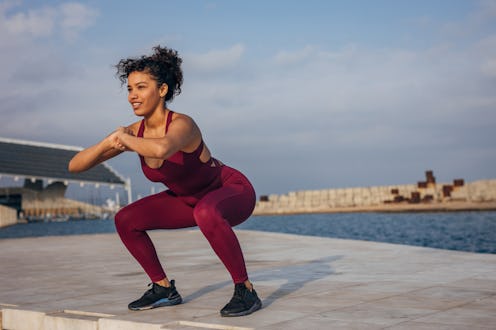Fitness
TikTok's "Iron Knee" Challenge Will Test Your Mobility
Are your knees well-oiled or rusty?

Your knees are one of those things you take for granted right up until they start to get stiff. The moment you feel a twinge while sitting at your desk or a twang while working out is the moment your FYP lights up with mobility tests — like TikTok’s iron knee challenge — so that you can evaluate what’s going on. (TikTok always knows what’s up.)
With over 5 million likes, the iron knee challenge is the latest from Dr. Dan, DPT, a TikTok-famous physical therapist who shares a variety of strength and mobility tests. This one is a series of squats designed to test your knee mobility, as well as your balance and overall lower body strength. If your knees are iron-strong and “well-oiled”, as Dr. Dan says in his video, the test should be relatively easy. If it feels tough or impossible to do, it might indicate that your lower body needs a little extra love.
According to Lalitha McSorley, PT, a physical therapist with Brentwood Physiotherapy Calgary, your knee health is influenced by several different factors, including joint structure, previous injuries, and overall joint health. If your knees feel extra stiff or get achy, it’s best to go to a doctor for an evaluation. McSorley says they’ll have you do things like single-leg squats, step-downs, and other range-of-motion tests to figure out what’s up.
If you’re curious to see if you have iron knees, according to Dr. Dan’s test, keep on scrolling. The mobility challenge is a fun way to test your strength at home — and it feels pretty great when you nail it.
How To Do The Iron Knee Challenge
Step your feet shoulder-width apart and lower your booty down into a deep squat. Try to keep your heels on the ground. Once you’re in a deep squat, glide your knees forward until your shins are parallel with the floor.
At this point, start balancing on your toes. Stay on your toes as you rise up to stand. Keep balancing on your toes as you drop back down into the position where your shins are parallel to the floor. From there, lower your heels and rock back to the deep squat position, then stand up.
After trying the challenge, one person commented, “My balance laughing at me” while someone else said, “My knees turned to dust watching this.” It’s definitely a challenge, but it should be doable if you have healthy knees as well as good balance and strong leg muscles.
What Does The Iron Knee Challenge Test?
While it’s called the iron knee challenge, this movement also calls on your balance as well as the strength and mobility of your lower body. If you’re able to do the deep squat — especially with your feet flat on the floor — it means you have pretty good knee and hip mobility plus lower body flexibility, says Mary Sabat, MS, RDN, LD, an ACE-certified personal trainer.
As you lean forward and make your shins parallel with the ground, it tests the strength and control of your quad muscles on the front of your legs, as well as your glutes and calf muscles, since they engage to help you stand up. “It also uses the muscles of the core, including the abdominals and lower back, to maintain balance and stability,” Sabat tells Bustle.
Finally, as you stand fully upright, the challenge calls on your quads, glutes, and calves once again, along with your balance, so that you can stay on your tippy toes. (That part is tougher than it looks.)
“While healthy knees are important for performing this challenge, other factors like joint stability, ligament health, and overall joint function also contribute to knee health,” Sabat adds, so remember to check in with a physical therapist if your knees start to hurt.
How To Get Healthier Knees
Let’s say you tried the iron knee challenge and immediately tipped backwards. To boost your lower body strength, Sabat recommends adding a few quad-strengthening exercises to your routine, like squats, lunges, leg presses, and step-ups. Since the quad muscles help support your knees, these moves will improve your joint health, too, by keeping the knees stable.
Strengthening the backs of your legs is also key, so aim for hamstring curls and deadlifts to target the muscles on the back of your body, aka your hamstrings, glutes, and calves. “This will help balance muscle strength around the knee joint,” Sabat says.
To work your glutes, McSorley suggests bridges, lunges, and hip thrusts, as well as low-impact exercises like swimming and cycling. Add in stretches to loosen up your quads, hamstrings, and calves, and it’ll all work together to enhance the flexibility and mobility of your knee joint. That way, the next time a test from Dr. Dan rolls around, you’ll be primed and ready.
Studies referenced:
Zhaoyang, R. (2019). Daily Sedentary Behavior Predicts Pain and Affect in Knee Arthritis. Ann Behav Med. doi: 10.1093/abm/kay073.
Sources:
Lalitha McSorley, PT, physical therapist with Brentwood Physiotherapy Calgary
Mary Sabat, MS, RDN, LD, ACE-certified personal trainer
This article was originally published on